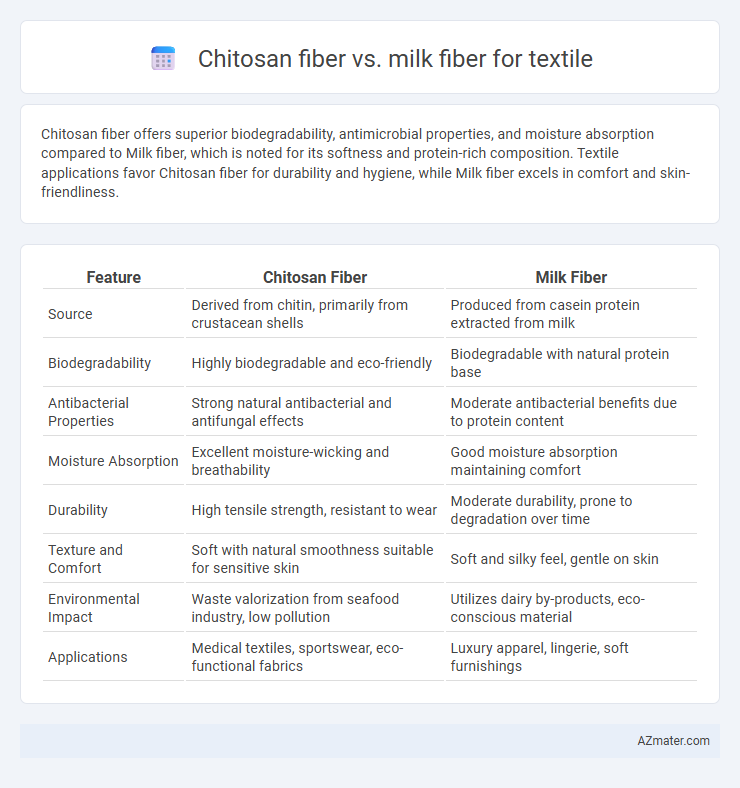Chitosan fiber offers superior biodegradability, antimicrobial properties, and moisture absorption compared to Milk fiber, which is noted for its softness and protein-rich composition. Textile applications favor Chitosan fiber for durability and hygiene, while Milk fiber excels in comfort and skin-friendliness.
Table of Comparison
| Feature | Chitosan Fiber | Milk Fiber |
|---|---|---|
| Source | Derived from chitin, primarily from crustacean shells | Produced from casein protein extracted from milk |
| Biodegradability | Highly biodegradable and eco-friendly | Biodegradable with natural protein base |
| Antibacterial Properties | Strong natural antibacterial and antifungal effects | Moderate antibacterial benefits due to protein content |
| Moisture Absorption | Excellent moisture-wicking and breathability | Good moisture absorption maintaining comfort |
| Durability | High tensile strength, resistant to wear | Moderate durability, prone to degradation over time |
| Texture and Comfort | Soft with natural smoothness suitable for sensitive skin | Soft and silky feel, gentle on skin |
| Environmental Impact | Waste valorization from seafood industry, low pollution | Utilizes dairy by-products, eco-conscious material |
| Applications | Medical textiles, sportswear, eco-functional fabrics | Luxury apparel, lingerie, soft furnishings |
Introduction to Chitosan and Milk Fibers
Chitosan fiber, derived from chitin found in crustacean shells, offers remarkable antimicrobial properties and biodegradability, making it a sustainable choice for advanced textile applications. Milk fiber, produced from casein protein extracted from milk, provides softness, moisture absorption, and biodegradability, enhancing comfort and eco-friendliness in fabrics. Both fibers represent innovative natural alternatives to synthetic materials, promoting environmental sustainability and functional performance in the textile industry.
Raw Material Sources and Sustainability
Chitosan fiber, derived from chitin found in crustacean shells, offers a sustainable alternative by utilizing seafood industry waste, reducing environmental impact. Milk fiber is produced from casein protein extracted from surplus milk, promoting the use of renewable agricultural by-products but requiring significant water and energy inputs. Both fibers emphasize biodegradability and eco-friendly attributes, yet chitosan fiber stands out for its waste valorization and antimicrobial properties, advancing the sustainability of textile raw materials.
Production Processes Compared
Chitosan fiber production involves extracting chitosan from crustacean shells, followed by dissolving it in specific solvents and regenerating it into fibers through wet spinning techniques, which ensures biodegradability and antimicrobial properties. Milk fiber is produced by extracting casein protein from milk, mixing it with other polymers, then spinning the mixture using dry or wet spinning methods to create soft, breathable textile fibers with a silky texture. Both processes emphasize eco-friendly, renewable resources but differ in raw material source and chemical treatment complexity, influencing the final fiber characteristics and application suitability.
Eco-Friendliness and Biodegradability
Chitosan fiber, derived from crustacean shells, offers superior eco-friendliness due to its renewable source and natural antimicrobial properties, enhancing textile longevity while reducing chemical treatments. Milk fiber, produced from casein proteins extracted from dairy by-products, is biodegradable and soft but generally requires more energy-intensive processing and chemical treatments compared to chitosan fiber. Both fibers biodegrade efficiently, but chitosan's competitive edge lies in its lower environmental impact and added functional benefits, making it a more sustainable choice for eco-conscious textile manufacturing.
Mechanical Properties: Strength and Durability
Chitosan fiber exhibits superior tensile strength and excellent abrasion resistance compared to milk fiber, making it highly durable for textile applications. The unique molecular structure of chitosan provides enhanced elasticity and resilience under mechanical stress. Milk fiber, while softer and more flexible, generally shows lower tensile strength and quicker wear, limiting its longevity in high-stress textile uses.
Comfort and Skin Compatibility
Chitosan fiber exhibits superior moisture-wicking and antimicrobial properties, enhancing comfort and reducing skin irritation, making it ideal for sensitive skin. Milk fiber offers a soft texture with natural protein-based nutrients that promote skin hydration and smoothness, contributing to gentle skin compatibility. Both fibers provide excellent breathability, but chitosan's antibacterial benefits give it an edge in maintaining skin health during prolonged wear.
Dyeing and Color Fastness Qualities
Chitosan fiber exhibits excellent dye absorption and superior color fastness due to its natural amino groups that enhance dye bonding, resulting in vibrant and long-lasting hues. Milk fiber, composed of casein proteins, provides moderate dye affinity but generally shows lower color retention and fading resistance compared to chitosan fiber. The antimicrobial properties of chitosan fibers further contribute to maintaining fabric color integrity during prolonged use and washing cycles.
Applications in the Textile Industry
Chitosan fiber offers antibacterial and moisture-wicking properties, making it ideal for medical textiles, sportswear, and hygiene products. Milk fiber, rich in amino acids, provides excellent softness and skin compatibility, favored in luxury textiles and skincare-related fabrics. Both fibers enhance functional textiles, with chitosan emphasizing antimicrobial performance and milk fiber enhancing comfort and biodegradability.
Cost and Market Accessibility
Chitosan fiber typically incurs higher production costs due to its complex extraction process from crustacean shells, making it less accessible in mainstream textile markets compared to milk fiber, which is derived from casein protein and benefits from more established manufacturing techniques and supply chains. Milk fiber's affordability and ease of integration into existing textile factories enhance its market penetration, especially in mass-market apparel and home textiles. Cost-efficiency and scalability thus favor milk fiber, while chitosan fiber targets niche markets with antimicrobial and biodegradable properties despite higher expenses.
Future Prospects and Innovations
Chitosan fiber, derived from crustacean shells, offers superior antimicrobial properties and biodegradability, making it highly promising for sustainable textile innovations. Milk fiber, produced from casein protein, excels in softness and moisture management but faces challenges in large-scale production and durability enhancements. Future prospects focus on integrating nanotechnology with chitosan fiber to boost performance and developing eco-friendly, scalable methods to enhance milk fiber's strength and commercial viability in smart textiles.

Infographic: Chitosan fiber vs Milk fiber for Textile
 azmater.com
azmater.com